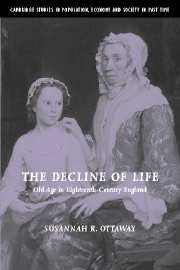Book contents
- Frontmatter
- Contents
- List of figures
- List of tables
- Acknowledgments
- List of abbreviations
- Introduction: Old age in eighteenth-century England: no “golden age of aging”
- 1 Who was “old” in eighteenth-century England?
- 2 The activities of the “helmsman”: self-reliance, work, and community expectations of the elderly
- 3 “The comforts of a private fire-side”
- 4 Independent but not alone: family ties for the elderly
- 5 Community assistance to the aged under the Old Poor Law
- 6 Continuity and change in community assistance to the elderly over the eighteenth century
- 7 Within workhouse walls: indoor relief for the elderly
- Conclusion: Old age as a useful category of historical analysis
- Bibliography
- Index
7 - Within workhouse walls: indoor relief for the elderly
Published online by Cambridge University Press: 15 December 2009
- Frontmatter
- Contents
- List of figures
- List of tables
- Acknowledgments
- List of abbreviations
- Introduction: Old age in eighteenth-century England: no “golden age of aging”
- 1 Who was “old” in eighteenth-century England?
- 2 The activities of the “helmsman”: self-reliance, work, and community expectations of the elderly
- 3 “The comforts of a private fire-side”
- 4 Independent but not alone: family ties for the elderly
- 5 Community assistance to the aged under the Old Poor Law
- 6 Continuity and change in community assistance to the elderly over the eighteenth century
- 7 Within workhouse walls: indoor relief for the elderly
- Conclusion: Old age as a useful category of historical analysis
- Bibliography
- Index
Summary
Changes in poor relief to the elderly were not confined to the arena of relief “out of doors.” Although poor relief in the eighteenth century was never dominated by indoor assistance, the workhouse was an important tool for reformers and also a potent symbol of oppression to the poor. Moreover, the impact of the workhouse takes on new relevance when one focuses on the elderly poor; both small, parochial workhouses and large, incorporated houses of industry played a disproportionately large role in the lives of the aged poor. In fact, workhouses increasingly supplemented outdoor relief for the elderly in many parishes. Here, we examine in depth the policies followed in Terling's and Ovenden's workhouses and the quality of care offered therein, and we trace some of the reasons for the increasing institutionalization of the elderly. Both houses played an important role in their communities' system of welfare provisions for the aged, and in Terling, in particular, we can see that the workhouse replaced outdoor relief for many of the elderly in the 1790s.
The image of the workhouse has lurked darkly in the imagination of the English people for centuries. An object of fear and loathing, it has been associated with Dickensian cruelty to children and has served as the ultimate symbol of neglect and despair for old men and women sunk in poverty and abandoned by their families.
- Type
- Chapter
- Information
- The Decline of LifeOld Age in Eighteenth-Century England, pp. 247 - 276Publisher: Cambridge University PressPrint publication year: 2004
- 1
- Cited by

